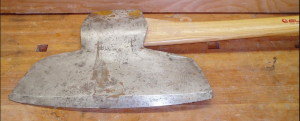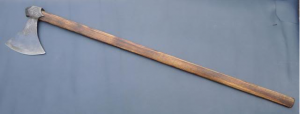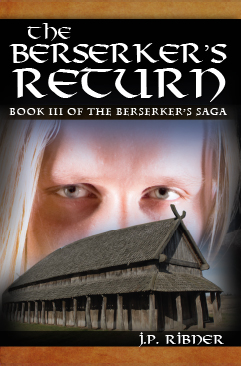When it comes to Vikings, there are a lot of myths and misunderstandings about these ancient, seafaring Nords. As a writer of Viking fantasy fiction, I often get questions based on these misconceptions. Take the picture above. I shared it because it perpetuates two common mistakes people make when they imagine Vikings. First, they did NOT have horns on their helmets. (That’s a separate blog past for another time.) The second misconception has to do with their weapons. No, Vikings did NOT carry huge, double-headed axes into battle. Still, I often get questions like the one below…
Q: What unique or unusual techniques did the Vikings have for fighting with the two handed broad axe?
A: The ancient Scandinavian peoples, aka the Norse, had three special techniques they used the broad axe for: ship building, splitting logs, and building homes. None of these activities involved fighting… provided everyone was getting along that day.
Meet the “Viking Broad Axe…”
The picture above is a broad axe. It was a common tool among the Norse and other European peoples during the Middle Ages. Due to its large, broad blade, it was a favorite among many ancient people’s for ship building, timber cutting, and other associated trades and crafts. Its broad, heavy blade made it well suited to the task of chopping, cutting, and even shaping wood. These same characteristics made the broad axe a horrible choice for a weapon. Simply put, its head was much to big and heavy to be effectively used in battle. This would especially be true if someone needed two hands to wield it.
The Brutality of Medieval Combat
There’s something you need to know about fighting with swords, shields, axes, spears, etc. It’s not like you see in the movies. A real swordfight during the Medieval ages wasn’t a series of fancy strikes, blocks, parries, and other assorted swordplay. The typical battle engagement often had two people swinging at each other more or less at the same time. The winner was the one who either struck first, or managed to strike his opponent’s vital organ. Sometimes this would be enough to kill an opponent; but most of the time, it left warriors critical injured, bleeding, and dying slowly on the battlefield. With the enemy quickly incapacitated, the victorious warrior could move on to his next combatant, etc.
Fights back then were fast and vicious. A warrior had to be quick, accurate, and know where to strike in order to be victorious. And he had to do this multiple times, since battles involved hundreds if not thousands of combatants. So, knowing this, stamina also comes into play. A broad axe would simply be two heavy and unruly to use effectively, fight after fight after fight. The average warrior who tried to wield this weapon likely wouldn’t survive his first encounter, let alone several over the course of a chaotic battle.
Two-Handed Weapons
Now that you have a better understanding of the vicous brutality of Medieval combat, let’s take a look at two-handed weapons. Generally speaking, these were considered a gamble on the part of the warrior. A two-handed weapon often gave more range and dealt greater damage, but it also meant sacrificing a hand that could be used to hold a shield to help protect oneself. In Las Vegas terms, a two-handed weapon is tantamount to putting ALL your money on one roll of the dice, or one pull of the slot machine.
Remember what I said above about the broad axe being too heavy and unbalanced as a combat weapon? As a two-handed axe, it would be too big a gamble to use. Attacks from two handed weapons cannot be disguised or hidden behind a shield. (You can’t even use a shield if both of your hands are holding your weapon!) Given the nature of two handed weapons and the broad axe, a Viking couldn’t help but telegraph every attack. An opponent would see the swing coming and counter attack quickly and easily. In most cases, an opponent could skewer his enemy mid-swing with his broadaxe. In other words, it’s all risks with no rewards.
If a broad axe were ever used to kill someone in battle, it likely would be a weapon of last resort from a frightened villager during a raid. If he/she were to get the kill, it would most likely be a “lucky shot.” Even then, I don’t like the broad axe-wielder’s chances when up against weapons designed for faster, more accurate attacks.
The Authentic Viking Axe…
See the axe in the above pic? It was called a “Dane axe,” and it’s a real Viking axe. Notice the long length of its handle? This definitely makes it a two-handed weapon. Now, compare the size of the blade to that of the broadaxe. Much smaller, right? It’s smaller and, more importantly, lighter than the broad axe or those huge, double-headed fantasy axes that artists keep putting in Viking warriors’ hands. In the right hands, this light but deadly axe would make quick attacks at a distance, but still sharp and heavy enough to do damage.
Dane Axe Fighting Techniques
If you’re in search for special Viking axe techniques, the Dane axe is your huckleberry. Since there aren’t many written records of Viking battle tactics, much of how these weapons were used is up to speculation. Fortunately, swordfighting isn’t rocket science Some say the Dane axe was a favorite of Viking warriors who engaged in fierce, ship-to-ship battles. It’s been said that Viking warriors in two longboats would tie their craft together at sea to allow their occupants to do battle. The fighting was fierce, and the fear of damaging your ship or your enemy’s ship could doom everyone to a watery grave.
How did the Dane Axe come into play? Allegedly, those armed with these weapons would use the long handle to reach over their opponents’ shields. Once they did that, the “beard” of the axe was used to catch the top of the opponent’s shield and pull it down, or pull the warrior off balance. By exposing the enemy, other members of the Viking fighting unit would finish off the enemy whose shield was pulled.
Chopping attacks with the Dane Axe were believed to be done at an angle. Apparently, this made for easier recovery of the weapon for the user. It also lessened the risk of breaking the axe’s long handle on an opponent’s shield, blade, or helmet. Vikings wielding this axe might have also use the other end of the handle to bash opponents in the face, etc. That would make for another unique or unusual technique, I suppose.
Given my kickboxing background, I know all about the damage that kicks to the leg can do. My kickboxing brain sees this as a possible technique for the Dane axe – using it to chop at your opponent’s legs. The length of the axe’s handle might let a warrior chop at oncoming legs at a fairly safe distance compared to shorter weapons. Truth be told, there were probably a variety of ways to use this weapon in battle. Those techniques probably differed upon the skill and experience of the individual warrior using the axe.
Send Me Your Viking Questions…
Do you have a question about Vikings? I’m happy to do my best to answer it. Feel free to send your questions to me in the comments section of this post and I’ll answer it to the best of my ability and knowledge on the subject of these ancient Nordic warriors, traders, and seafarers.
About Indie Author J.P. Ribner
J.P. Ribner is the author of the Viking fantasy adventure series, The Berserker’s Saga. Currently, the saga features three novels – Legacy of the Bear, Prophecy of the Bear, and The Berserker’s Return. He’s also in the process of editing Wasted Youth: A Flint Punk Rock Memoir. Born and raised in Flint, Michigan, J.P. now lives in the Metro Detroit area with his wife and three sons.







Hi how bout conditing for axe weilding and thecqunices to use a double handed axe
Nice write up. I’d add one bit… because they were light and were used against foes with relatively light armor, ive seen demonstrations where the axe is used to trust, using the top tip of the axe like a spear. So part of the technique would be thrusting. So something like aiming high and catching a foes shield on the withdraw absolutely set up the axe weirder to thrust forward at their foe before he could readjust his shield and without aid of a companion to attack the foe before he recovered the shield. I’ve heard these kind of techniques influenced how bills and halberds were made. Cheers!
I was under the impression that vikings often used axes for fighting over swords due to availability and cost. Swords were far more.expensive than axes. That said, fighting with a shield was important. Is it possible that a dane axe would have been carried with a shield? And if was specialized to only certain warriors did the majority of warriors use swlrds or axes? I have seen lots of posts like yours that all seem to disagree on this point or at least, do not confirm fully each other.
Erik:
You are right in assuming axes (and spears) were more common than swords, generally speaking, because of the scarce availability of iron in Scandinavia. Most of the metal they got for weapons-making was found in small bits and pieces and taken from peat mud. Warriors who owned swords either had the money to pay for one to be made, captured enemy swords in battle, and traded for ingots of iron from areas where the ore was more available.
In regards Dane axes, my research indicates it was a two-handed weapon primarily used to to strip enemies of their shields, or at least pull their shields down. These axes were often used in ship-to-ship battles for that purpose. Given the length of the Dane ax’s handle, I just can’t see it being used with a shield.